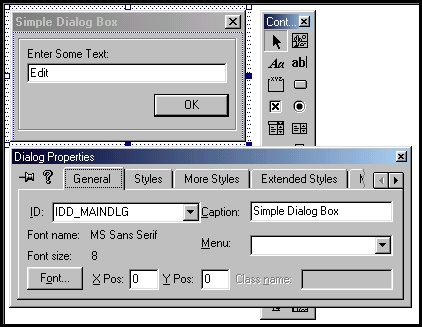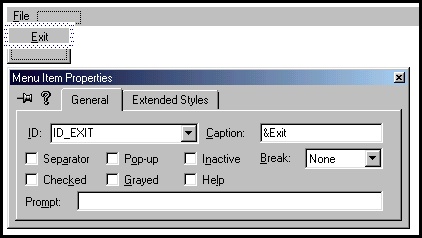Dialog boxes are very common to most Windows programs. They're usually
there to accept input, but their uses are endless. The two main kinds of dialog box windows are
modal and modeless. A modal dialog box has a parent window that you typically can't
access or continue working with while the dialog is active. An example would be notepad. Run notepad and select
"Open" from the file menu. When the file selection dialog window pops up, notice that you can't
access the main notepad edit window until you close the dialog window. Modeless dialog boxes are different
because you can leave them open and the application can continue operating at the same time allowing you
to switch between the two if you'd like. Dialog boxes have many uses and variations including many possible controls to be placed on them (such as edit boxes, list boxes, combo boxes, progress meters, etc).
I couldn't possibly sit here and explain how to work with every kind of control in a reasonable amount of time, so I'll just give a brief explanation of how to create a dialog box and how to use a simple control or two.
The rest is up to you to figure out, but most controls work in similar ways.
The first step we'll take in creating a dialog window is actually designing the thing and placing controls.
Take a look at the following screenshot of the previously mentioned resource editor:

Which translates to the following in the resource file:
IDD_MAINDLG DIALOG DISCARDABLE 0, 0, 153, 164
STYLE DS_MODALFRAME | WS_POPUP | WS_CAPTION | WS_SYSMENU
CAPTION "Simple Dialog Box"
FONT 8, "MS Sans Serif"
BEGIN
DEFPUSHBUTTON "OK",IDOK,65,114,50,14
GROUPBOX "",IDC_OUTLINE,3,5,146,81
EDITTEXT IDC_EDITBOX,9,19,133,12,ES_AUTOHSCROLL
LTEXT "Enter Some Text:",IDC_STATICENTER,9,9,89,9
END
|
Again, you don't have to design your dialog boxes in a resource editor, but it makes
life a whole lot happier if you're interested in how wisely you use your time.
Now that we have our dialog window designed, how do we actually make it go? A dialog window
is just that -- a window. It has a window procedure and receives messages too. But in order
to create one, we first must choose where to make it modal or modeless. Here are examples of both:
// Create a Modal Dialog Box
int success = DialogBox(hInstance, // instance handle;
MAKEINTRESOURCE(IDD_MAINDLG), // dialog identifier;
hWndParent, // parent/owner handle;
DlgProc); // window procedure;
// If <i>success</i> is -1, the operation failed;
|
// Create a Modeless Dialog Box
HWND dlg = CreateDialog(hInstance, // instance handle;
MAKEINTRESOURCE(IDD_MAINDLG), // dialog identifier;
hWndParent, // parent/owner handle;
DlgProc); // window procedure;
if(dlg==NULL) {
return 0;
} else ShowWindow(dlg,SW_SHOW);
|
As you can see, creating either type is not too difficult. Because I didn't mention before, I will now:
MAKEINTRESOURCE is simply a macro that converts an integer into a compatible resource value.
There are also other ways to create dialog boxes, but the above methods work out well. An important
note to make when working with modeless dialog boxes is a function called IsDialogMessage,
whose parameters are the dialog window handle and the current message from within the message loop. The
function checks whether the message is for the dialog box in question and processes it if indeed it is.
If the function succeeds (non-zero return), then you don't need to translate or dispatch the
message because it has been taken care of already by IsDialogMessage.
Now we'll take a look at the dialog procedure. As you can see, its not too different from
our previous window procedure:
BOOL CALLBACK DlgProc(HWND dlg, UINT msg, WPARAM wParam, LPARAM lParam) {
switch(msg) {
case WM_INITDIALOG:
return TRUE;
case WM_COMMAND:
switch(LOWORD(wParam)) {
case IDOK:
{
char dlgStr[20];
if(GetDlgItemText(dlg, IDC_EDITBOX, (LPTSTR)dlgStr, 20))
MessageBox(dlg, dlgStr, "Text Message", MB_OK);
return TRUE;
} return TRUE;
}
return FALSE;
case WM_CLOSE:
EndDialog(dlg, IDOK);
return TRUE;
}
return FALSE;
}
|
Again, the window procedure checks for "WM_COMMAND", this time checking to see if the button has
been pressed. If it has, it calls GetDlgItemText to retrieve the text from the
edit box called IDC_EDITBOX and repeats the text in a message box window. The functions
used should be pretty self-explanatory. EndDialog is used to destroy our dialog box.
You can change that to exit code or anything else you'd like. The "WM_INITDIALOG" message is
received when the dialog box is initialized, before it is visible. This is the place where
most people put initialization code or set up dialog box controls. |






